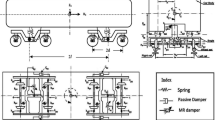Abstract
Designing the suspension system of a tracked combat vehicle (CV) is really challenging as it has to satisfy conflicting requirements of good ride comfort, vehicle handling and stability characteristics. Many studies in this field have been reported in literature and it has been found that torsion bars satisfy the designer’s conflicting requirements of good ride and handling and thus have reserved a place for themselves as the most widely used suspension system for military track vehicles. Therefore, it is imperative to evaluate the effectiveness of the torsion bar under dynamic conditions of undulating terrain and validating the same by correlating it with computer simulation results. Thus in the present work, the dynamic simulation of a 2N + 4 degrees of freedom (DOF) mathematical model has been carried out using MATLAB Simulink and the vibration levels were also measured experimentally on a 12 wheel stationed high mobility military tracked infantry combat vehicle (ICV BMP-II) traversing different terrain, that is, Aberdeen proving ground (APG) and Sinusoidal, at a constant vehicle speed. The dynamic force transmitted to the hull CG through the 12 torsion bar suspension systems was computed to be around 26,700 N and found to match the measured values. The vibration isolation of the torsion bar in bounce was found to be effective, with a transmissibility from the road wheel to the hull of about 0.6.

















Similar content being viewed by others
Abbreviations
- ai :
-
Longitudinal distance of ith road wheel from CG
- bi :
-
Lateral distance of ith road wheel from CG
- \({\text{C}}_{{{\text{di}}}}\) :
-
Damping coefficient for ith wheel
- \({\text{C}}_{{{\text{seat}}}}\) :
-
Damping coefficient for driver’s seat
- \({\text{I}}_{{\text{p}}}\) :
-
Pitch moment of inertia
- \({\text{I}}_{{\text{r}}}\) :
-
Roll moment of inertia
- \({\text{I}}_{{\text{y}}}\) :
-
Half pitch moment of inertia
- \({\text{K}}_{{{\text{seat}}}}\) :
-
Stiffness of driver’s seat
- \({\text{K}}_{{{\text{tbi}}}}\) :
-
Stiffness of ith torsion bar
- \({\text{K}}_{{{\text{wi}}}}\) :
-
Stiffness of ith road wheel
- \({\text{m}}_{{\text{h}}}\) :
-
Half hull sprung mass
- \({\text{M}}_{{\text{h}}}\) :
-
Hull sprung mass
- \({\text{T}}_{{{\text{ri}}}}\) :
-
Track tension
- X:
-
Longitudinal axis
- Y:
-
Lateral axis
- Z:
-
Vertical axis
- \({\ddot{{\text{Z}}}}_{{\text{h}}}\) :
-
Vertical acceleration response of hull
- \(\dot{{\text{Z}}}_{{\text{h}}}\) :
-
Vertical vibration velocity of hull
- \({\text{Z}}_{{\text{h}}}\) :
-
Bounce motion of hull
- \(\ddot{\text{z}}_{\text{wi}}\) :
-
Vertical acceleration response of ith road wheel station
- \(\dot{\text{z}}_{\text{wi}}\) :
-
Vertical velocity of ith road wheel station
- \({\text{z}}_{\text{wi}}\) :
-
Bounce motion of ith road wheel station
- \({\text{z}}_{\text{ri}}\) :
-
Road input to ith road wheel
- θ:
-
Pitch (about Y-axis)
- θ:
-
Pitch of hull CG
- φ:
-
Roll (about X-axis)
- φ:
-
Roll of hull CG
- Φ:
-
Yaw (About Z-axis)
References
G.H. Hohl, Torsion-bar spring and damping systems of tracked vehicles. J. Terrramech. 22(4), 195–203 (1986)
S. Rakheja, M.F.R. Alfanso, S. Sankar, Dynamic analysis of tracked vehicles with trailing arm suspension and assessment of ride vibrations. Int. J. Veh. Des. 13(1), 56–77 (1992)
A. Dhir, S. Sankar, Analytical track models for ride dynamic simulation of tracked vehicles. J. Terrramech. 31(2), 107–138 (1994)
A. Dhir, S. Sankar, Assessment of tracked vehicle suspension system using a validated computer simulation model. J. Terrramech. 32(3), 127–149 (1995)
C. Sujatha, A.K. Goswami, J. Roopchand, Vibration and ride comfort studies on tracked vehicle. Int. J. Veh. Des. 9(3), 241–252 (2002)
J. Yamakawa, K. Watanabe, A spatial motion analysis model of tracked vehicles with torsion bar type suspension. J. Terramech. 41(2), 113–126 (2004)
H. Baokun, Multibody model and simulation of the tracked vehicles, in Proceedings of International Conference on Computer, Mechatronics, Control and Electronic Engineering (CMCE), pp. 200–202
Z.A. Kadir, M.A.M. Naiem, B. Bohari, K.A. Jalil, M.F.M. Yusoff, Validation of 2 dof tracked vehicle model due to road disturbance. J. Mech. Eng. 1(3), 15–18 (2012)
A.M. Salem, T. Salahuddien, Evaluation of characteristics of tracked vehicle torsion bars. http://www.academia.edu/8651499/Evaluation_of_Characteristics_of_Tracked_Vehicles_Torsion_Bars3
Acknowledgements
The authors acknowledge the support received from Ordnance Factory, Medak and Combat Vehicles Research and Development Establishment, Chennai, India for conducting the experiments and would like to thank them. Further, necessary funding for the study was provided by IIT Madras.
Funding
Funding was provided by IIT Madras.
Author information
Authors and Affiliations
Corresponding author
Appendix: Specifications of Sinusoidal and APG Track Profile
Appendix: Specifications of Sinusoidal and APG Track Profile
Sinusoidal Track Profile

APG Track Bumps

APG Track Profile

Rights and permissions
About this article
Cite this article
Gagneza, G.P.S., Chandramohan, S. Estimation of Road Loads and Vibration Transmissibility of Torsion Bar Suspension System in a Tracked Vehicle. J. Inst. Eng. India Ser. C 100, 747–761 (2019). https://doi.org/10.1007/s40032-018-0460-8
Received:
Accepted:
Published:
Issue Date:
DOI: https://doi.org/10.1007/s40032-018-0460-8




